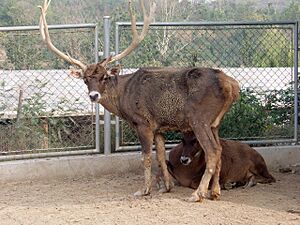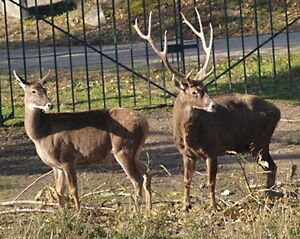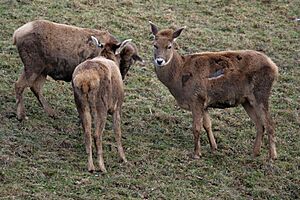Thorold's deer facts for kids
Quick facts for kids Thorold's deer |
|
|---|---|
 |
|
| Stag (male) Thorold's deer. | |
 |
|
| Pair of Thorold's deer; doe (female) at left, stag (male) to right. | |
| Conservation status | |
| Scientific classification | |
| Genus: |
Cervus
|
| Species: |
albirostris
|
| Synonyms | |
|
Przewalskium albirostris |
|
The Thorold's deer (scientific name: Cervus albirostris) is a large deer species. It lives in the high mountains of the eastern Tibetan Plateau in China. You can also find it in some scattered areas further north in central Western China. This deer is considered a threatened species.
It is also known as the white-lipped deer. This name comes from the white fur around its nose and mouth. In Simplified Chinese, it's called baichunlu (白唇鹿). In Standard Tibetan, it's ཤྭ་བ་མཆུ་དཀར།.
Thorold's deer is one of the biggest ungulates (hoofed mammals) in its home range. It plays a similar role in nature to the Tibetan red deer. A scientist named Nikolay Przhevalsky first described it in 1883. In 2011, over 100 of these deer lived in zoos worldwide. In 1998, experts thought about 7,000 were left in the wild.
Contents
What's in a Name?
Even though Nikolay Przhevalsky first described this deer in 1883, it's also called "Thorold's deer." This is because G. W. Thorold collected some deer specimens in 1892. Later, in 1893, W. T. Blanford described them as Cervus thoroldi.
The scientific name albirostris comes from Latin. Albus means "white" and rostrum means "snout." This refers to the deer's white muzzle and lips. The Chinese name baichunlu (白唇鹿) also means "white-lipped." This is why it's commonly known as the white-lipped deer.
Deer Family Tree
Thorold's deer has always been part of the Cervus group of deer. Recent genetic studies show that this is the correct place for it. There are no different types or subspecies of Thorold's deer recognized.
Appearance and Features
Thorold's deer is one of the largest deer species. It stands about 115 to 140 cm (45 to 55 in) tall at the shoulder. Male deer are much larger than females. Males usually weigh 180 to 230 kg (400 to 510 lb), while females weigh 90 to 160 kg (200 to 350 lb).
Their fur is rough and grey-brown over most of their body. It turns yellowish-buff on their belly. They have a clear reddish-brown patch on their rump. A ridge of darker hair runs down their back. In winter, their coat becomes lighter and twice as thick. It's even thicker than a moose's fur!
The head is darker, especially in males. This contrasts with the pure white markings on their lips, around their nose, and on their throat. Adult males have antlers that can be up to 110 cm (43 in) long and weigh up to 4 kg (8.8 lb). Their antlers are flatter than those of wapiti or red deer. They can have up to seven points, all lying in the same flat shape. The deer shed their antlers every March, and they grow back fully by late summer.
Other special features include longer ears with white hair inside. They also have large glands near their hooves and eyes. Their hooves are wide and heavy, with unusually long dewclaws (small toes). Their tail is short, only about 12 to 13 cm (4.7 to 5.1 in) long.
Thorold's deer have special body features that help them live in high mountains. Their short legs and wide hooves make them good climbers. This helps them escape predators on steep slopes. They have very large nasal passages to help them breathe the thin air at high altitudes. Their thick fur keeps them warm. Their red blood cells are smaller and more numerous than in other mammals their size. This helps them take in more oxygen from the limited air.
Where They Live
Thorold's deer mainly live in the Chinese provinces of Tibet, Sichuan, Qinghai, Gansu, and northwestern Yunnan. However, they are found only in scattered groups. They seem to be most common in eastern Sichuan Province.
These deer prefer a mix of grassland, shrubland, and forest. Their ideal home is often high above the treeline (where trees stop growing). They live at elevations between 3,500 to 5,100 metres (11,500 to 16,700 ft). This makes them one of the highest-living deer species in the world!
Thorold's deer also move between different elevations depending on the season. When it gets cold in autumn, they move down from their high summer pastures. They go to lower, sheltered woodlands and valleys. They stay there for the winter.
Daily Life and Habits
Thorold's deer are most active at dawn and dusk. They usually live in herds of at least 10 deer. Male herds and female-juvenile (young) herds stay separate until breeding season. Older males often travel alone or with a small group of other males. In the past, herds with hundreds of deer were seen. Today, it's rare to see herds of more than 50 to 100 deer.
Like wapiti, these deer mostly eat plants that grow low to the ground. They eat many types of grasses and sedges. Sometimes, they also eat larger plants like rhododendrons and willows. They don't have many natural enemies. Himalayan wolves and snow leopards sometimes hunt them. Stray or wild dogs might attack young deer.
Thorold's deer make different sounds. They have loud alarm calls, screams, and whistles that can be heard over 500 m (1,600 ft) away. Males make bellows and growls during the breeding season. Females and young deer make quieter grunts and mews. Like reindeer, they can also make strange, loud snapping sounds from their leg bones. It's not clear why they do this. Thorold's deer rarely run, but they can gallop up to 35 miles (56 km) per hour.
Reproduction and Life Cycle
The breeding season, called the rut, happens between September and November. During this time, herds with both males and females become more common. These herds have several males, each protecting a small group of females from other males. Males fight each other like other deer do. They wrestle with antlers, use scent to mark their territory, show off, and make warning grunts. Mating is quick.
After being pregnant for 220 to 250 days, the female gives birth to one young deer. This usually happens in May or June. Before giving birth, the mother finds a hidden spot, often in bushes. The baby deer are born with white spots. They can stand about 40 minutes after birth. At first, the mother moves them to different places to protect them. She only visits them twice a day to let them drink milk. After about two weeks, the young deer rejoin the herd.
The calves' spots start to disappear after about six weeks. They get their full adult color by the end of their first year. They can have their own babies when they are two or three years old. However, males usually don't successfully breed until they are at least five years old. Thorold's deer have lived up to 21 years in zoos. In the wild, they probably live no more than 12 years.
Protecting Thorold's Deer
Thorold's deer are found in scattered groups. It's hard to study them because they live in remote, high-altitude areas. They face threats from humans expanding farms. Domestic animals like sheep, goats, and yaks compete with them for food. People also hunt them for their meat, antlers, and other body parts. These parts are used in traditional Chinese medicine.
The IUCN (International Union for Conservation of Nature) lists Thorold's deer as vulnerable. In China, it is a Class I protected species. This means it has the highest level of protection.
Some Thorold's deer are raised on farms in China and New Zealand for their antlers. They are also found in many zoos around the world. They seem to do well even when kept at lower altitudes.
See also




